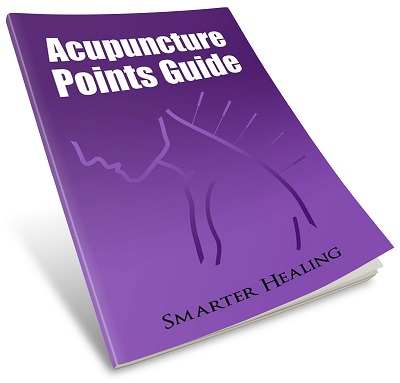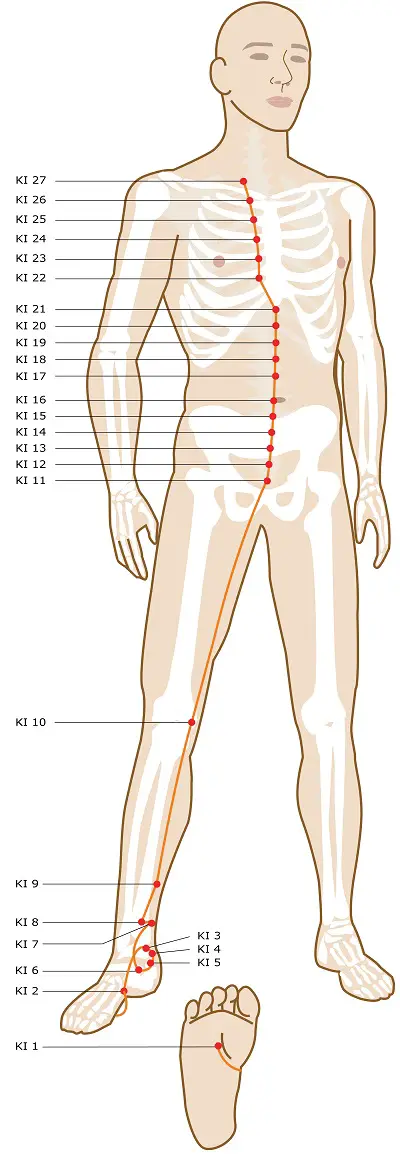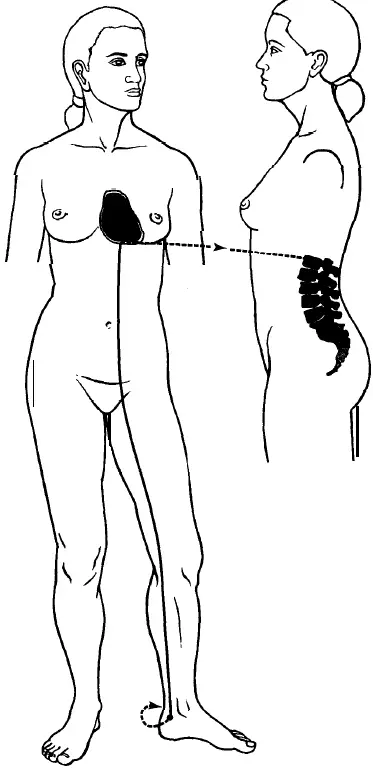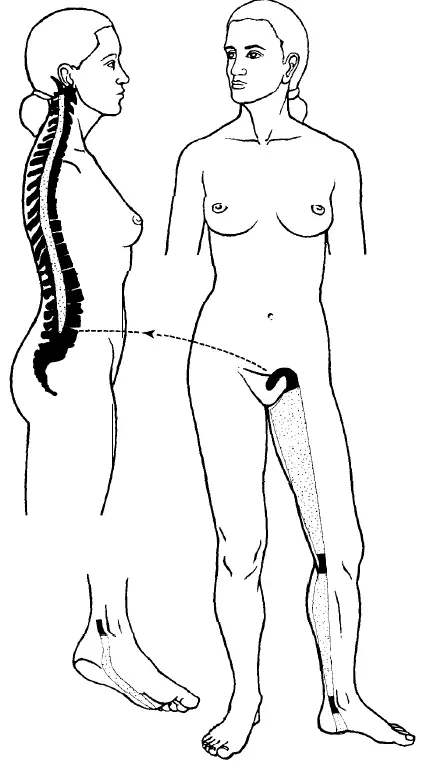

Kidney Meridian Points
KI 1: yong quan / Gushing Spring
Function: Tonifies yin, clears heat, subdues wind, subdues empty-heat, calms the mind, restores consciousness, clears the brain.
Indications: Headache, blurring of vision, dizziness, sore throat, dryness of tongue, loss of voice, dysuria, infantile convulsions, feverish sensation in the sole, loss of consciousness.
KI 2: ran gu / Blazing Valley
Function: Clears empty-heat, cools blood, invigorates Yin Motility Vessel.
Indications: Pruritus vulvae, prolapse of uterus, irregular menstruation, nocturnal emission, hemoptysis, thirst, diarrhea, swelling and pain of the dorsum of foot, acute infantile omphalitis.
KI 3: tai xi / Great Ravine
Function: Tonifies the Kidneys, benefits essence, strengthens the lower back and knees, regulates the uterus.
Indications: Sore throat, toothache, deafness, tinnitus, dizziness, spitting of blood, asthma, thirst, irregular menstruation, insomnia, nocturnal emission, impotence, frequency of micturition, pain in the lower back.
KI 4: da zhong / Large Goblet
Function: Strengthens the back, lifts the spirit.
Indications: Spitting of blood, asthma, stiffness and pain of the lower back, dysuria, constipation, pain in the heel, dementia.
KI 5: shui quan / Water Spring
Function: Benefits urination, promotes blood circulation, stops abdominal pain, regulates uterus.
Indications: Amenorrhea, irregular menstruation, dysmenorrhea, prolapse of uterus, dysuria, blurring of vision.
KI 6: zhao hai / Shining Sea
Function: Nourishes yin, benefits the eyes, calms the mind, invigorates the Yin Motility Vessel, cools the blood, benefits the throat, promotes the function of the uterus, opens the chest, cools heat, calms spirit, benefits throat.
Indications: Irregular menstruation, morbid leukorrhea, prolapse of uterus, pruritus vulvae, asthma, frequency of micturition, urine retention, constipation, epilepsy, insomnia, sore throat.
KI 7: fu liu / Recover Flow
Function: Tonifies the Kidneys, resolves damp, eliminates edema, strengthens the lower back, regulates sweating.
Indications: Edema, abdominal distension, diarrhea, borborygmus, muscular atrophy of the leg, night sweating, spontaneous sweating, febrile diseases without sweating.
KI 8: jiao xin / Intersection Reach
Function: Removes obstructions from the channel, stops abdominal pain, removes masses, regulates menses.
Indications: Irregular menstruation, dysmenorrhea, uterine bleeding, prolapse of uterus, diarrhea, constipation, pain and swelling of testes.
KI 9: zhu bin / Guest House
Function: Calms the mind, tonifies Kidney yin, opens chest, regulates the Yin Linking Vessel.
Indications: Mental disorders, pain in the foot and lower leg, hernia.
KI 10: yin gu / Yin Valley
Function: Expels dampness from the Lower Energizer, tonifies Kidney yin.
Indications: Impotence, hernia, uterine bleeding, dysuria, pain in the knee and popliteal fossa, mental disorders.
KI 11: heng gu / Pubic Bone
Function: Boosts the Stomach and disinhibits damp.
Indications: Fullness and pain of the lower abdomen, dysuria, enuresis, nocturnal emission, impotence, pain of genitalia.
KI 12: da he / Great Manifestation
Function: Supplements Kidney Qi, regulates the Penetrating and Conception vessels.
Indications: Nocturnal emission, impotence, morbid leukorrhea, pain in the external genitalia, prolapse of uterus.
KI 13: di xue / Qi Hole
Function: Tonifies the Kidneys and essence, removes obstructions from the channel.
Indications: Irregular menstruation, dysmenorrhea, dysuria, abdominal pain, diarrhea.
KI 14: si man / Fourfold Fullness
Function: Supplements Kidney Qi, regulates the Penetrating and Conception vessels, promotes free flow through the waterways.
Indications: Abdominal pain and distension, diarrhea, nocturnal emission, irregular menstruation, dysmenorrhea, postpartum abdominal pain.
KI 15: zhong zhu / Central Flow
Function: Nourishes the Kidney channel, regulates the Penetrating and Conception vessels, disinhibits the Lower Energizer.
Indications: Irregular menstruation, abdominal pain, constipation.
KI 16: huang shu / Vitals
Function: Removes obstructions from the channel, tonifies the Kidneys, benefits the Heart.
Indications: Abdominal pain and distention, vomiting, constipation, diarrhea.
KI 17: shang qu / Intestine Bend
Function: Fortifies Spleen, disinhibits damp, soothes sinews, quickens the connecting vessel.
Indications: Abdominal pain, diarrhea, constipation.
KI 18: shi guan / Stone Pass
Function: Fortifies the center and harmonizes Stomach, frees intestines and abducts stagnation.
Indications: Vomiting, abdominal pain, constipation, postpartum abdominal pain, sterility.
KI 19: yin du / Yin Metropolis
Function: Fortifies the Spleen and harmonizes the Stomach, regulates Qi dynamic and frees abdominal Qi, regulates the Penetrating and Conception vessels.
Indications: Borborygmus, abdominal pain, epigastric pain, constipation, vomiting.
KI 20: tong gu / Open Valley
Function: Fortifies the Spleen and harmonizes the Stomach, loosens the chest and rectifies Qi.
Indications: Abdominal pain and distension, vomiting, indigestion.
KI 21: you men / Dark Gate
Function: Abdominal pain and distension, indigestion, vomiting, diarrhea, nausea, morning sickness.
Indications: Courses the Liver and rectifies Qi, fortifies the Spleen and harmonizes the Stomach, clears abdominal heat.
KI 22: bu lang / Corridor Walk
Function: Diffuses the Lung and suppresses cough, downbears counterflow and stops vomiting.
Indications: Cough, asthma, distension and fullness in the chest and hypochondriac region, vomiting, anorexia.
KI 23: shen feng / Spirit Seal
Function: Tonifies the Kidneys, calms the mind.
Indications: Cough, asthma, fullness in the chest and hypochondriac region, mastitis.
KI 24: ling xu / Spirit Ruings
Function: Tonifies the Kidneys, calms the mind.
Indications: Cough, asthma, fullness in the chest and hypochondria region, mastitis.
KI 25: shen cang / Spirit Storehouse
Function: Tonifies the Kidneys, calms the mind.
Indications: Cough, asthma, chest pain.
KI 26: yu zhong / Lively Center
Function: Loosens chest and promotes smooth flow of Qi, calms dyspnea and relieves cough.
Indications: Cough, asthma, accumulation of phlegm, fullness in the chest and hypochondriac region.
KI 27: shu fu / Shu Mansion
Function: Stimulates the Kidney function of reception of Qi, subdues rebellious Qi, stops cough, calms asthma, resolves phlegm.
Indications: Cough, asthma, chest pain.
Primary Functions
- Influencing the reproductive organs, growth of the body in general and bodily development.
- Controlling the production of bone marrow, brain material and fluids, and the health of the bones in general.
- Aiding the production of blood cells.
- Dominating water and fluids throughout the body.
- Controlling the reception of chi energy.
- Influencing the health of the ears.
- Dominating the anus and urethra.
Common Uses
- Aiding in the removal of pathogens from the head.
- Treating night sweating.
- Treating excessive thirst.
- Treating wasting disorder (excessive deterioration of muscle and fat).
- Aiding in the treatment of headaches and dizziness caused by Liver meridian energy disruption.
- Balancing Kidney fluid levels.
- Reducing restlessness, insomnia, poor memory, palpitations, epilepsy, mania, and susceptibility to fright.
- Aiding the lungs in the treatment of cough, coughing up blood, dyspnoea (difficult breathing), asthma, wheezing, and other lung-related illness.
- Strengthening the kidneys in the treatment of edema (swelling caused by fluid retention), and urinary disorders.
- Strengthening Kidney meridian energy to increase sexual libido, and to treat impotence, seminal emission issues, and other sexual disorders.
- Strengthening Kidney meridian energy to improve body heat in the lower torso, legs, and feet.
- Strengthening the lower spinal area.
- Improving the health of the teeth.
- Increasing the health of the ears, such as while treating tinnitus and hearing deficiency.
- Treating diseases of the uterus such as infertility, menstruation disorders, uterine prolapse, post-partum disorders, and other reproductive problems.
- Improving the function of the bladder and intestines to treat difficult urination, retention of urine, painful urinary tract, overly dark or discolored urine, diarrhea, dysentery, hernia, and more.
- Treating itching, pain, or swelling of the genitals.
- Treating pain of the lower abdominal area.
- Removal of constipation caused by dryness or fluid imbalance, related to the kidneys' ability to regulate the body's fluids.
Kidney Meridian Channels & Sinews
The Kidney meridian is the only acupuncture meridian that features a point on the bottom of the foot.
The meridian begins here at acupoint KI1 and travels up the leg, until it reaches near the center of the torso, where it continues up the body until it ends near the collarbone area on the upper chest.
But the Kidney meridian also features several extraneous channels of energy that branch off of it and influence nearby parts of the body.
Let's take a look at the Kidney secondary energy channels.

First up we have the Kidney luo-connecting channel, which begins on at acupoint KI4 on the side of the foot.
From the ankle, the luo-connecting channels goes two directions.
Part of it circles behind the ankle and connects with the Bladder meridian near acupoint BL60 on the back of the ankle.
But the main portion of the luo-connecting channel travels up the leg alongside the primary Kidney meridian.
Once it reaches the groin area, it travels up the center of the torso until it hits the center of the chest slightly below the pericardium (the tissue surrounding the heart).
From there, the Kidney luo-connecting channel goes back into the middle back portion of the spine.

Next up is the Kidney divergent channel.
This energy pathway appears at the back of the knee area, where it disconnects from the primary Kidney meridian near acupoint KI10.
It travels up the back of the leg, through the buttocks, and up the back all the way until it reaches the neck.
On its way through the leg, it connects with the Bladder divergent channel.
It also passes through the physical kidney in the torso area, as well as the Girdling vessel near the waist.
At the top of the pathway, it reaches inside the neck and passes through the base of the tongue.
From there, it emerges on the back of the neck where it ends by connecting with the primary Bladder meridian near the acupoint BL11.

Finally, we have the Kidney sinew channel.
This pathway of muscle and tissue begins beneath the little toe of the foot, near the first primary Kidney meridian acupoint KI1.
At this starting point, the Kidney sinew channel is partially connected to the Spleen sinew channel, which also begins on the foot.
The Kidney sinew channel binds to the ankle bone, then travels up the back side of the leg until it also binds to the knee bone area.
On its way up the upper leg, it partially rejoins with the Spleen sinew channel as it makes its way towards the genitals.
From the genital area, a branch of the Kidney sinew channel separates and traverses internally to the base of the spine, where it then travels up the entire spine.
Near the top of the spine, the Kidney sinew channel ends by converging with the Bladder sinew channel.
The 12 Primary Meridians
The 2 Major Extraordinary Vessels
The 6 Minor Extraordinary Vessels
Original article and pictures take www.smarterhealing.com site



